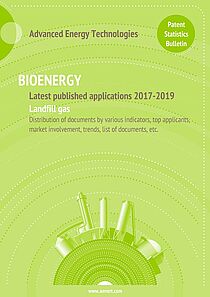Archive
BIOENERGY. Latest published applications 2017-2019. Landfill Gas

Summary
Landfill gas (LFG) is one of the main products generated by the decomposition of organic material in landfills. It contains a fairly equal ratio of methane and CO2, as well as small amounts of non-methane organic compounds. LFG can be captured and used as a renewable energy source. It is usually produced using several wells and a blower/flare or vacuum system, which directs the gas to a processing unit for conversion into energy products or flaring. LFG can be collected at both open and closed landfills; however, closed landfills tend to have a more developed collection infrastructure as active filling does not take place. Before you can process LFG it needs to be purified to remove particles, liquid, CO2, and nitrogen. Owing to the different degradation phases in a landfill and a various amount of air infiltration, the composition of LFG can differ depending on time and location. Once the gas has been treated it can be upgraded to the quality of natural gas to be injected into the gas distribution network. Although landfill gas production is a rather well-researched and straightforward process there still remain several technological and organisational problems, first and foremost related to safety of operation (fire hazard and explosions), ecological impact, plant siting, high operational and maintenance costs, all of which need suitable engineering solutions. LFG can also contain toxic organic and inorganic trace gases, such as chlorine, fluorine, sulphur, and silicon which can pose a threat to human health and the environment. The applications presented in this bulletin are aimed at resolving some of the aforementioned issues.
The proposed bulletin is dedicated to landfill gas and includes patent applications published in 2017-2019. Research methodology is available on the Advanced Energy Technologies website. The patent bulletin includes 857 patent documents. The applications were registered in 28 patent offices around the world. 346 applicants from 30 countries participated in the development of the inventions. 689 subgroups of the International Patent Classification were encountered in the patent documents.
Key Highlights
The bulletin contains statistical data on the distribution of patent documents by years, by patent offices and by applicant countries, applicant-related data (residents and non-residents), data on the most frequently mentioned International Patent Classification divisions (sections, classes, subclasses, groups, and subgroups). The top three patent offices that registered the largest number of patent applications were USPTO (US), CNIPA (CN) and WIPO.
For each of the patent documents selected for the examination in the present bulletin the characteristics of unified indicators were preliminary defined, they include: technical problems, types of inventive solutions employed, belonging to one or other technological segment. This allows the internal content for each of the indicators in the aggregate array of documents to be visualized, for instance, to define the sequence and proportional correlation of technical problems the inventive solutions disclosed in the texts aim to solve. A list of the top 10 groups consisting of patent documents with identical unified indicators contains ID numbers and applicant names of respective documents; the groups are sorted by the number of patent documents.
Data is provided for each of the top 10 applicants, leading in terms of the number of published patent documents among the ones examined in the bulletin, illustrating their share in the established intellectual property market, distribution of applications by problems, IPC sections, patent offices and technology indicators. Representatives of the United States prevail among the patenting leaders in the examined period of time, including: Haldor Topsoe A/S (DK), Evonik Fibres Gmbh (AT), Osaka Gas Corporation (JP), Ecolab (US), Mustang Sampling LLC (US), Johnson Matthey Plc (GB), Flourchemie GmbH Frankfurt (DE), King Abdullah University of Science and Technology (KAUST) (SA), UOP LLC (US), Waga Energy (FR).
The prominent documents pages contain the top 10 patent applications with the highest bibliographical rating, the most extensive coverage of IPC sections, and those not being a part of patent family.
The conclusive part of the bulletin represents the lists of all of the documents reviewed, arranged by the top 10 groups of patent documents with identical unified indicators and by patent offices with the indication of the ID numbers of the registered patent applications.
Who needs this bulletin?
The data provided in the proposed bulletin is a timely reflection of the transformations that take place in the intellectual property sector of the industrial direction concerned. Thoroughly edited selection of patent documents can become a good complement to your library of available technical solutions. The bulletin is targeted at inventors, engineers, researchers, managers and business administrators involved in the development of biofuel production technologies.


